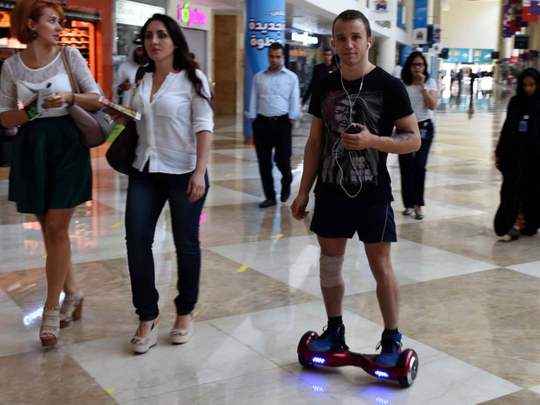
“Hoverboards, also known in the UAE as smart balancing wheels, are the latest tech craze sweeping the globe. Central London shop Spy Master is one of the few retailers in the UK that stocks the device in-store.
Among drones, Go-Pro action cameras and encryption equipment, the two-wheeled, brightly coloured gadgets apparently fly off the shelves. “Thousands” have been sold at the shop this year says the company’s director, Julia Wing. They offer a row of different models - including a blue IO Hawk, a large graffiti-adorned board, and a bright-green transporter with Bluetooth speakers - ranging between 500 pounds to around 1,500 pounds. “I think they’re so futuristic - it’s the first time we’ve seen anything like this,” Wing says. “Because celebrities have them now, it’s the thing to have.”
Hoverboards are mostly sold online, yet the fact that more people are uploading photos on to Instagram of themselves riding the devices, combined with the small amount of major retailers actually stocking them, has made them even more sought after.
The popularity of the hoverboard - otherwise knows as an e-board, swegway or self-balancing scooter - has increased recently and particularly since stars including Wiz Khalifa, 2 Chainz, Usain Bolt, Justin Bieber and Kylie Jenner have been spotted travelling around on them.
On most days, Spy Master sells around four hoverboards. Perhaps one of the most desired is the gold edition e-board, that sits on a glass shelf on the window surrounded by electric cycles, monocyles and handled Segways with large black wheels. “One Middle-Eastern customer came in this summer and bought 10,” says Wing, who also points out the strange coincidence that 2015 is also the year in which Marty McFly rides a hoverboard in Back to the Future Part II. “One customer said their grandchild is always trying something new on the board, and trying to see if they can balance on one leg,” she added.
Ikram Al Yacoub is a hoverboard owner from Dubai, said when the boards first started to become popular, they were unavailable on the market. “Most kids were trying to order one through Amazon and so teenagers then started to imitate one another until it became the coolest thing, for now,” she says.
Her nine year-old nephew now has one too, receiving it two months ago on his birthday. “The kids like it because you don’t use your hand to balance,” she says. “My nephew should only use it in the playground, and his mum will take it away if he plays it on the streets outside.”
The increased interest in hoverboards has also led to the Metropolitan police highlighting Crown Prosecution Service guidance that it is illegal to ride them in public in London.
A hoverboard usually has to be charged for two to three hours and rides last up to 20km with a top speed of 10 kms per hour. It operates by stepping on to a gyro-stabilised platform, and the direction of travel is controlled by pressing down on the rubber footpads while standing up straight.
“We tell all our customers that they can’t use this on the roads or pavements - but most of our customers interested in these have their own large private properties,” Wing says.
Around the corner at the department store Selfridges a sales assistant of Red5 gadgets wheeled around the shop floor on a hoverboard. “You can do anything”, he says, while demonstrating he can juggle or operate a remote-controlled helicopter at the same time as using the product.
“Everyone wants one, and there’s a buzz around it,” he says, as two young women tried one out, adding that he tells his customers that they are not allowed to ride one on the street, only on private property.
“We started stocking these last year, but it took us a while to look around,” he says. Hoverboards are made in factories in China, but due to difficulty in enforcing copyrights in the country, there is no single company or distributer for retailers to deal with.
The main difference between the varieties, from cheap knock-offs that can be purchased online for a few hundred pounds to ones that cost thousands of pounds, is mostly down to the label plastered on to the board, he says.
He pulls out two hoverboards from different distributors that are visibly identical - same rubber foot pads, colour, wheels, star-shaped detail on the hover cap, motors and lights - save for the boxes the devices were sold in.
Factory costs are around 150 pounds, he said, and the company sells each board for around GBP600. “But by Christmas, we’ll be selling them for much cheaper, around 400 pounds,” he said. The most successful day of sales was in September around Eid Al Adha, when the gadget company sold 20 of the devices.
The store sells four or five “on a quiet day” but expects to sell many more in the run-up to Christmas and on Black Friday. “For a lot of British families, it is at the top of the wish list.” But despite their apparent popularity, they are nowhere to be seen when the Guardian travelled to Oxford Street, Hyde Park or Stratford on a Monday lunchtime. Perhaps the Met’s advice has already taken hold. Only time will tell whether the hoverboard can become a crossover gadget regardless.
Guardian News & Media Ltd, 2015










